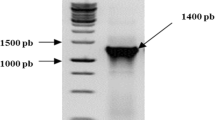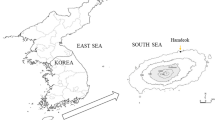Abstract
Pathological characteristics of olive flounder Paralichthys olivaceus experimentally infected with Streptococcus parauberis were studied. Various stressful conditions, aeration and netting stress in particular, led to induced mortality by S. parauberis. Netting stress-induced mortality was positively correlated to bacterial dose and stressful conditions. Inflammation of the heart and pericarditis was the major pathological change observed in olive flounder experimentally infected with S. parauberis. During the infected period, the number of bacteria in the infected olive flounder was recorded over time. S. parauberis remained in all fish organs tested, especially in the heart and brain.




Similar content being viewed by others
References
Kitao T (1993) Streptococcal infection. In: Inglis V, Roberts RJ, Bromage NR (eds) Bacterial diseases of fish. Blackwell, Oxford, pp 196–210
Austin B, Austin DA (1999) Gram positive bacteria-the lactic acid bacteria. In: Austin B, Austin DA (eds) Bacterial fish pathogens, disease in farmed and wild fish. Ellis Horwood, Chichester, pp 38–49
Ghittino C, Latini M, Agnetti F, Panzieri C, Lauro L, Ciappelloni R, Petracca G (2003) Emerging pathologies in aquaculture: effects on production and food safety. Vet Res Commun 27[Suppl 1]:471–479
Lee DC, Lee JI, Park CI, Park SI (2001) The study on the causal agent of Streptococcicosis (Lactococcus garvieae), isolated from cultured marine fishes. J Fish Pathol 14:71–80
Kim JH, Kim E (2003) Diversity of the streptococcal strains isolated from diseased olive flounder (Paralichthys olivaceus). J Kor Fish Soc 36:654–660
Jung YU, Kang CY, Kim MJ, Heo MS, Oh DC, Kang BJ (2006) Characterization of streptococcosis occurrence and molecular identification of the pathogens of cultured flounder in Jeju Island. Kor J Microbiol 42:199–204
Baeck GW, Kim JH, Gomez DW, Park SC (2006) Isolation and characterization of Streptococcus sp. from diseased flounder (Paralichthys olivaceus) in Jeju Island. J Vet Sci 7:53–58
Kim JH, Gomez DK, Baeck GW, Shin GW, Heo GJ, Jung TS, Park SC (2006) Pathogenicity of Streptococcus parauberis to Olive Flounder Paralichthys olivaceus. Fish Pathol 41:171–173
Cho MY, Oh YK, Lee DC, Kim JH, Park MY (2007) Geographical comparison on different methods for identification of Streptococcus parauberis isolated from cultured olive flounder, Paralichthys olivacues. J Fish Pathol 20:49–60
Kang CY, Kang BJ, Moon YG, Kim KY, Heo MS (2007) Characterization of Streptococcus parauberis isolated from cultured Olive flounder, Paralichthys olivaceus in the Jeju Island. J Fish Pathol 20:109–117
Williams AM, Collins MD (1990) Molecular taxonomic studies on Streptococcus uberis types I and II. Description of Streptococcus parauberis sp. nov. J Appl Bacteriol 68:485–490
Demenech A, Fernandez-Garayzabal JF, Pascual C, Garcia JA, Cutuli MT, Moreno MA, Collins MD, Dominguez L (1996) Streptococcosis in cultured turbot Scophthalmus maxiums (L.), associated with Streptococcus parauberis. J Fish Dis 19:33–38
Mata AI, Casamayor GA, Blanco MM, Domíngguz L, Frernández-Garayzábal JF (2004) Multiplex PCR assay for detection of bacterial pathogens associated with warm water streptococcosis in fish. Appl Environ Microbiol 70:3183–3187
Caruso D, Schlumberger O, Dahm C, Proteau JP (2002) Plasma lysozyme levels in sheatfish Silurus glanis (L.) subjected to stress and experimental infection with Edwardsiella tarda. Aquac Res 33:999–1008
Chen M, Yang H, Delaporte M, Zhao S (2007) Immune condition of Chlamys farreri in response to acute temperature challenge. Aquaculture 271:479–487
Kimura H, Kusuda R (1979) Studies on the pathogenesis of streptococcal infection in cultured yellowtails Seriola spp.: effect of the cell free culture on experimental streptococcal infection. J Fish Dis 2:501–510
Zhang XH, Austin B (2000) Pathogenicity of Vibrio harveyi to salmonids. J Fish Dis 23:93–102
Bradford MM (1976) A rapid and sensitive method for the quantitation of microgram quantities of protein utilizing the principle of protein-dye binding. Anal Biochem 72:248–254
Collins CH, Lyne PM (1976) Food microbiology in microbiological methods. Butterworth, London, pp 262–304
Bunch E, Bejerano I (1997) The effect of environmental factors on the susceptibility of hybrid tilapia Oreochromis niloticus × Oreochromis aureus to streptococcosis. Isr J Aquac 49:67–76
Stoffregen D, Backman S, Perham R, Bowser P, Babish J (1996) Initial disease report of Streptococcus iniae infection in hybrid striped (sunshine) bass and successful therapeutic intervention with the fluoroquinolone antibacterial enrofloxacin. J World Aquac Soc 27:420–434
Lee CH, Kim PY, Ko CS, Oh DC, Kang BJ (2007) Biological characteristics of Streptococcus iniae and Streptococcus parauberis isolated from cultured flounder, Paralichthys olivaceus, in JeJu. J Fish Pathol 20:33–40
Perera RP (1998) Histopathology of hybrid tilapias infected with a biotype of Strptococcus iniae. J Aquat Animal Heal 10:294–299
Cho MY, Lee JI, Kim MS, Choi HJ, Lee DC, Kim JW (2008) Isolation of Streptococcus parauberis from starry flounder, Platichthys stellatus Pallas. J Fish Pathol 21:209–217
Kusuda R, Kimura H (1978) Studies on the pathogenesis of streptococcal infection in cultured yellowtails Seriola spp.: the fate of Streptococcus sp. bacteria after inoculation. J Fish Dis 1:109–114
Locke JB, Colvin KM, Varki N, Vicknair MR, Nizet V, Buchanan JT (2007) Streptococcus iniae β-hemolysin streptolysin S is a virulence factor in fish infection. Dis Aquat Org 76:17–26
Acknowledgments
This study was financially supported by the Pukyong National University as part of its 2008 Post-Doctoral Program. This work was also supported by a grant for the National Fisheries Research and Development Institute (RP-2010-AQ-018).
Author information
Authors and Affiliations
Corresponding author
Rights and permissions
About this article
Cite this article
Won, K.M., Cho, M.Y., Park, M.A. et al. Pathological characteristics of olive flounder Paralichthys olivaceus experimentally infected with Streptococcus parauberis . Fish Sci 76, 991–998 (2010). https://doi.org/10.1007/s12562-010-0287-6
Received:
Accepted:
Published:
Issue Date:
DOI: https://doi.org/10.1007/s12562-010-0287-6




